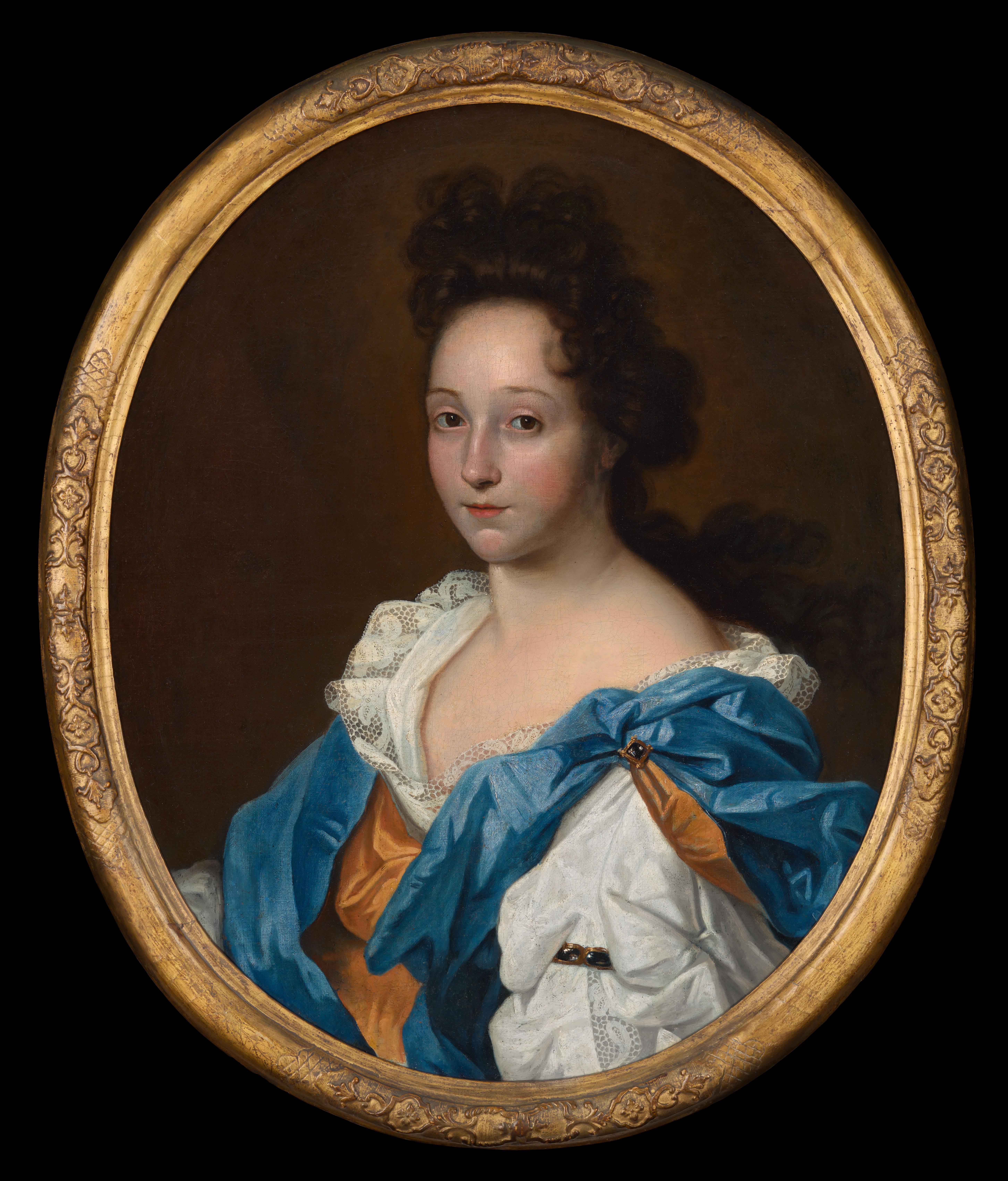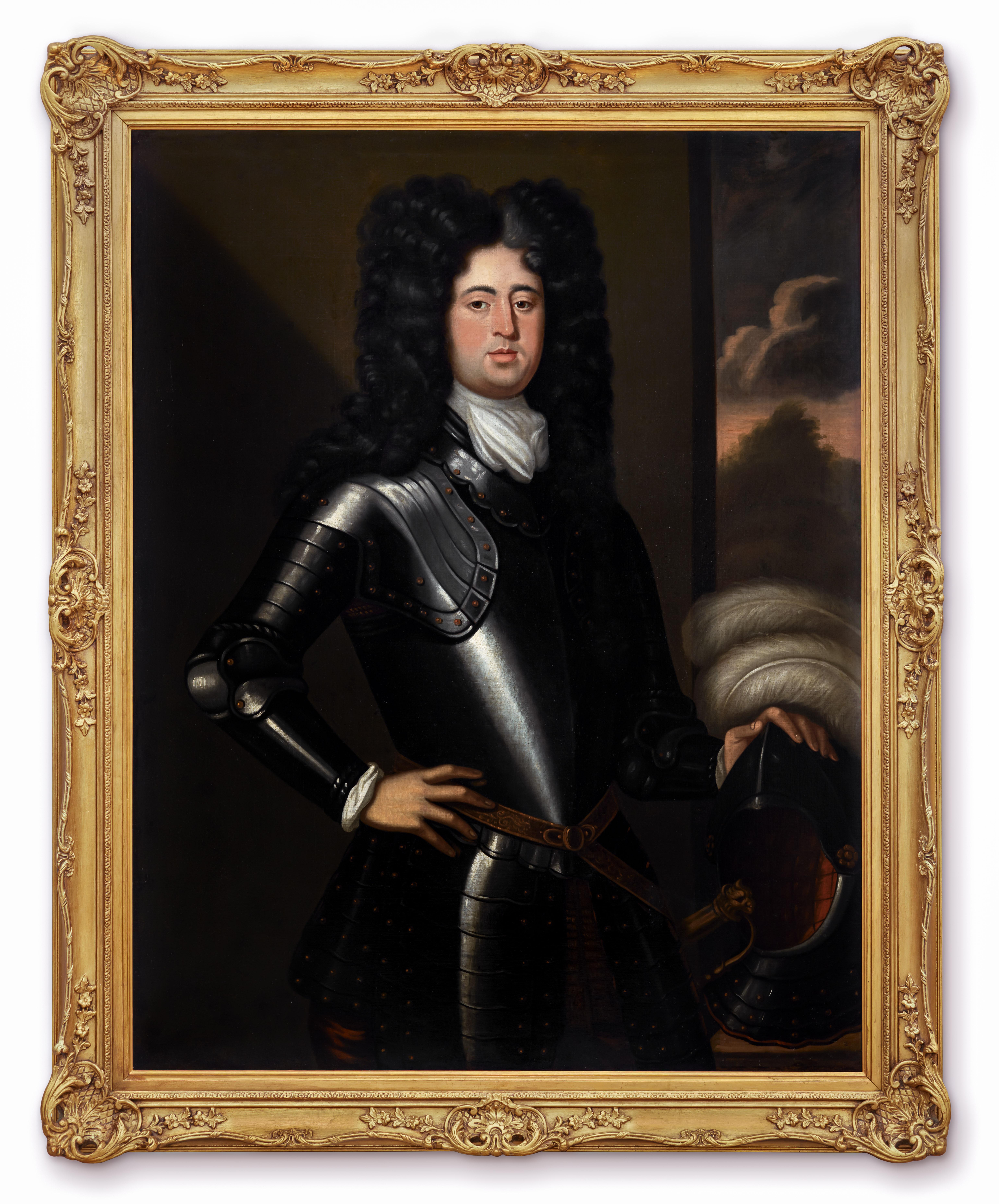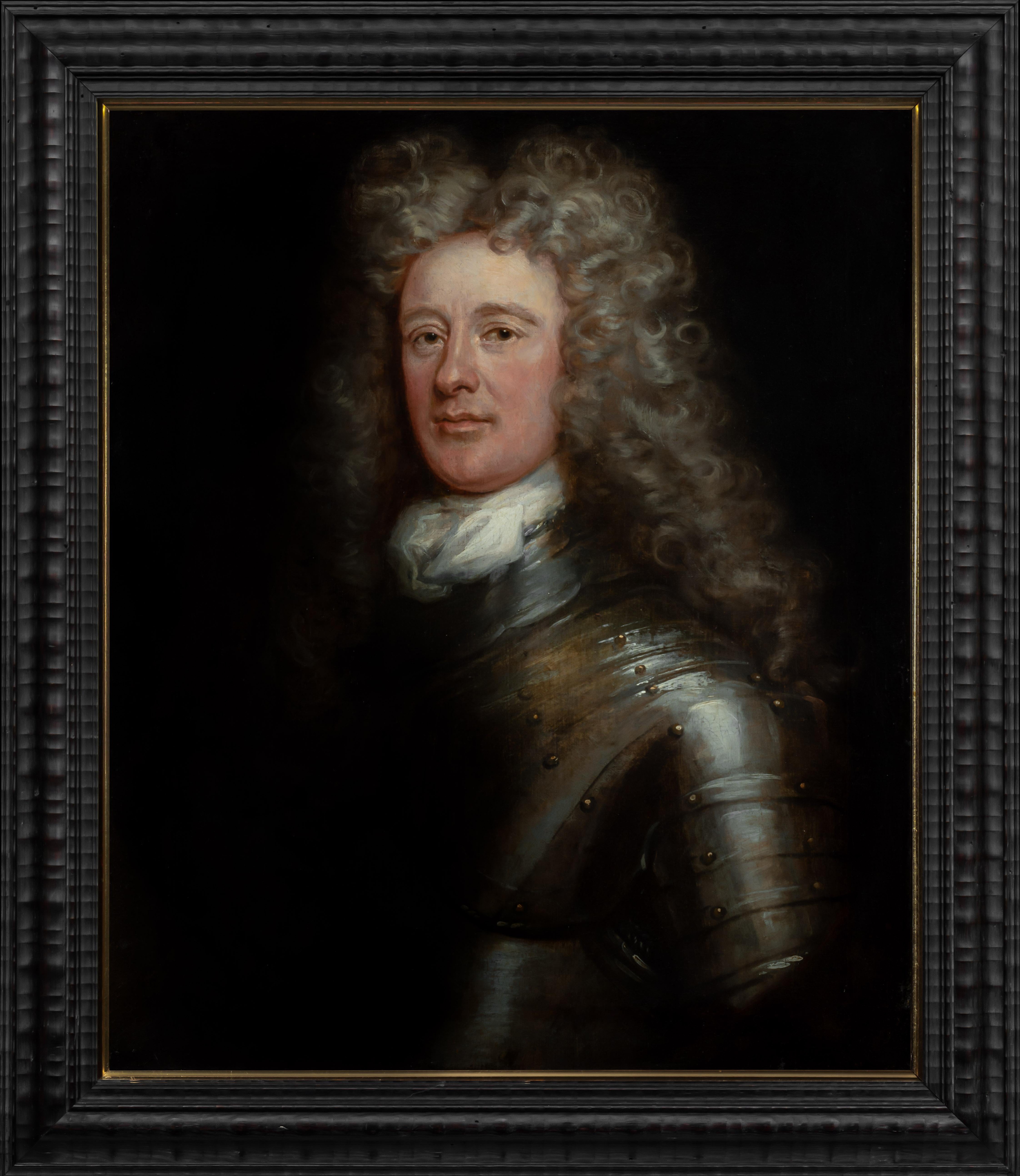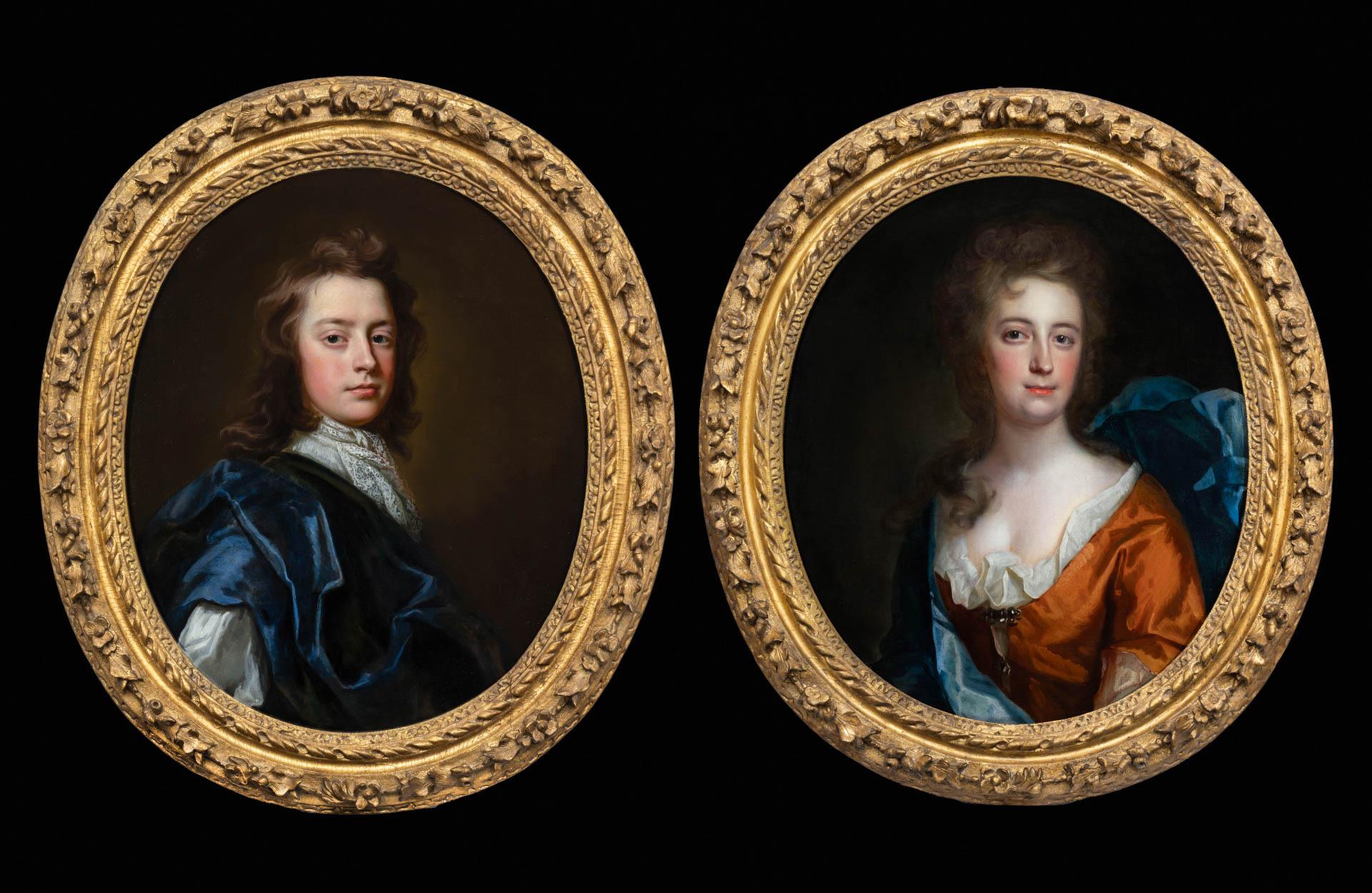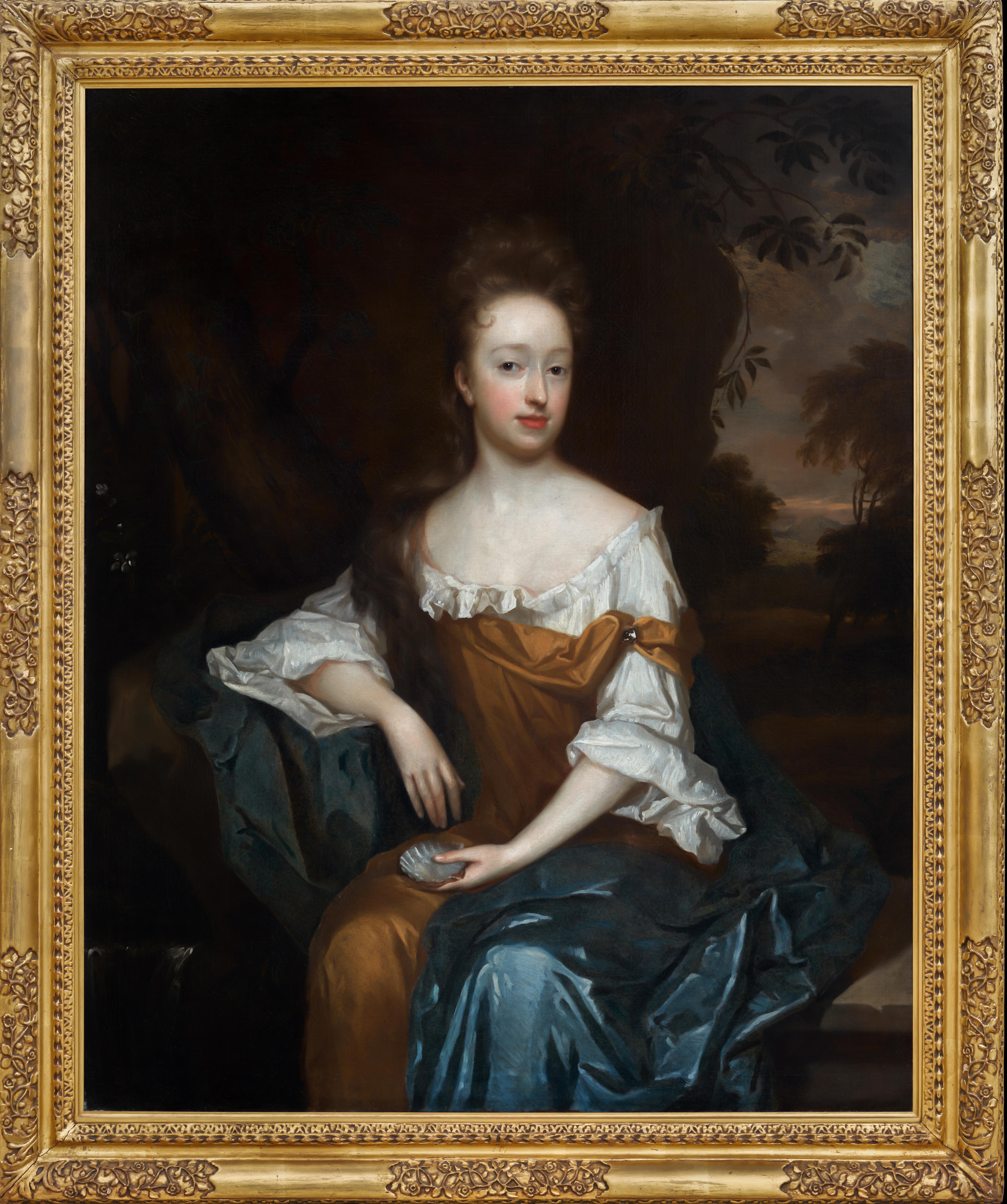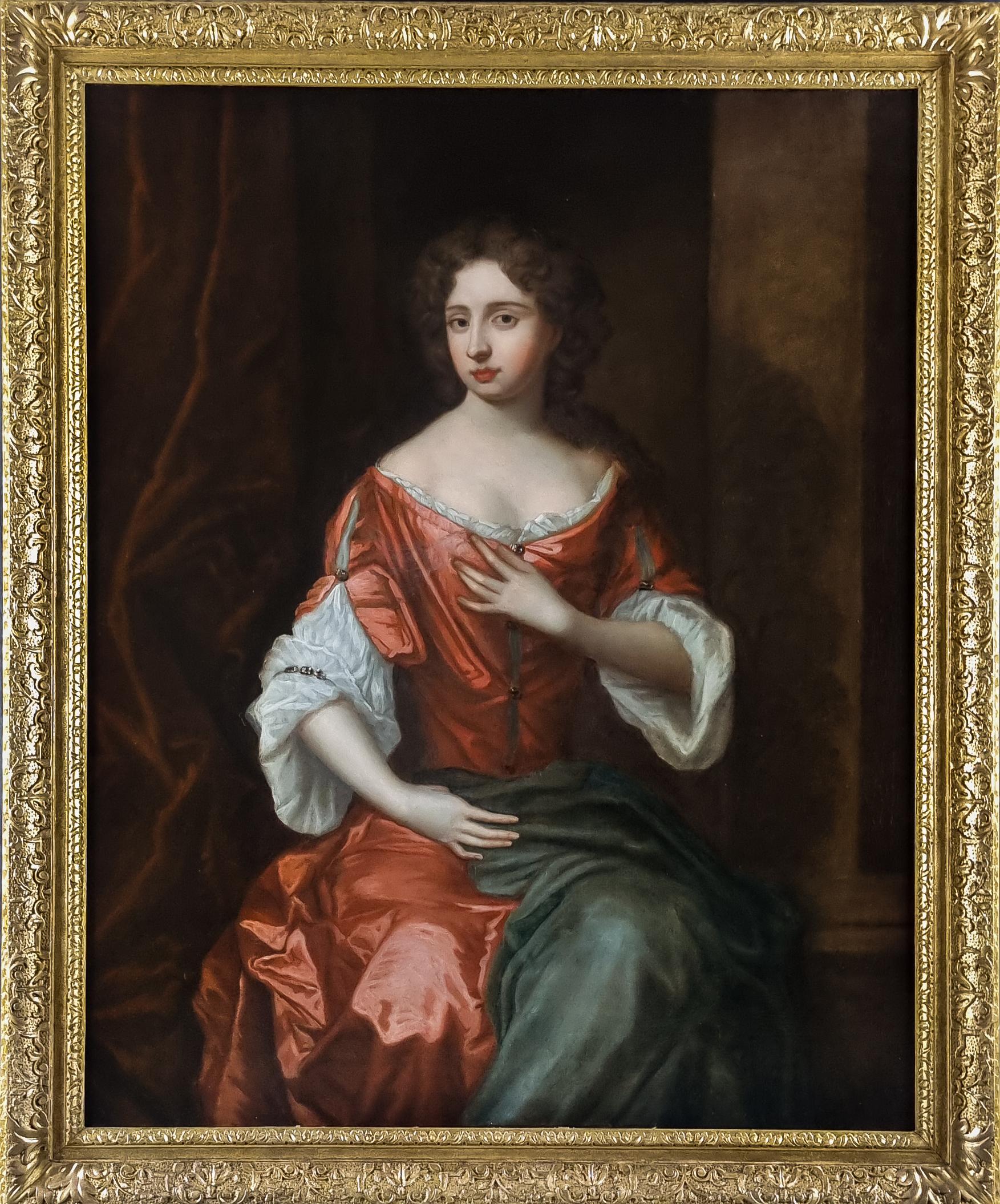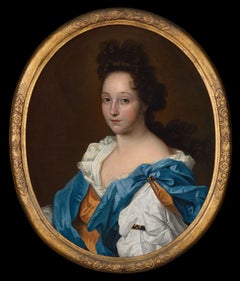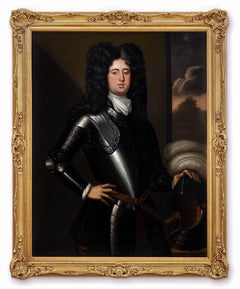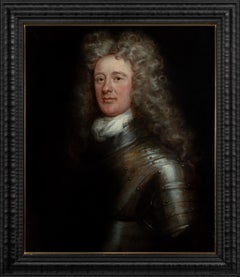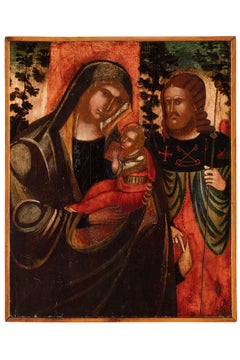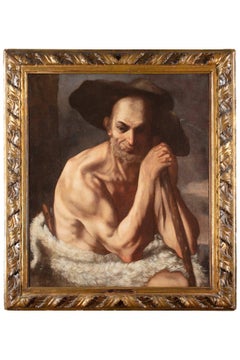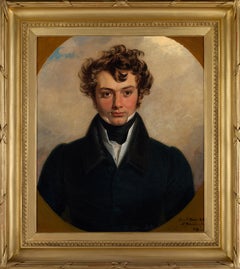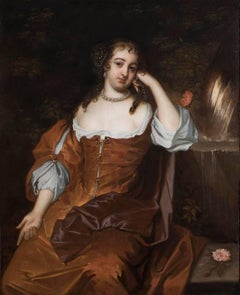Items Similar to Portrait of a Lady in Silk Dress & Blue wrap in oval, Mary Beale, Oil on canvas
Want more images or videos?
Request additional images or videos from the seller
1 of 12
Mary BealePortrait of a Lady in Silk Dress & Blue wrap in oval, Mary Beale, Oil on canvas1675-1680
1675-1680
About the Item
Portrait of a Lady in an Elaborate Stone Cartouche c.1675-80
Mary Beale (1632-1699)
Titan Fine Art present this superb portrait where the sitter has been portrayed wearing a low-cut white chemise under a gold silk robe with a draped light blue silk cape gathered at her left shoulder by a jewelled brooch. Her long brown hair is tied at back of neck and falls in loose curls about the face. The work was painted by Mary Beale, who was one of the first female portrait painters in England; today she enjoys a particular celebrity among the portraitists of the seventeenth century. This is not solely because she was a woman in a profession dominated by men, indeed, she was not alone in this: in “The Excellent Art of Painting” written in 1658 Sir William Sanderson records Mrs Beale among four named women painters practising in London. Rather it is because she competed so successfully with her colleagues, and was so prolific a painter: Additionally, through the diaries kept by her husband Charles, a former Clerk to the Patents Office, who became her studio assistant and colourman, we know more of her technique and working practice than that of any of her contemporaries, including Sir Peter Lely, and this has provided to historians today an invaluable record, unrivalled for the period, into the working life of an artist and their studio. Charles and Mary, together shared a passion not only for painting, but also the research of all the technical aspects behind its production. Whilst Mary executed the portrait commissions, Charles studiously experimented with pigments, mediums, canvases, and other materials that Mary needed'. His goal was to produce the finest materials and methods, at the most effective cost for Mary.
The precise details of Mary Beale's training remain obscure: her father John Craddock had been a member of the Painter-Stainers' Company, and had had his portrait painted by Robert Walker in the late 1640s. Walker was then pre-eminent among painters in London, particularly in the puritan circles that included Mary Beale's family, and it is, not unreasonably, supposed that Walker was her tutor in painting. In 1651 she married Charles Beale, a member of a prosperous family of Puritan gentry from Walton. Three years later their first son Bartholomew was born. Shortly afterward the painter and her family moved to Covent Garden, and began to associate with an erudite circle of artists, intellectuals and to clergymen that was to provide the base of her patronage in later years.
Initially, through his lucrative position at the Patent's Office, Charles was the main provider of the family's income. However, in 1665, with the Great Plague sweeping London and Charles losing his job, the Beales relocated from the city and took refuge at Albrook, a small village Hampshire. It was not until 1670, when she returned to London and their studio in Pall Mall, that she began her professional career in earnest. Our portrait, painted half-length set within a richly ornate faux cartouche surround, typical of the ‘Lelyesque’ design that was at the height of fashion at the time, probably dates from these first years in practice (this is further supported by the clothing and hairstyle). Sir Peter Lely (1618-1680), as Court Painter to Charles II and the most influential painter of the day, was an artist whom Mary and Charles both deeply admired. They worked hard to become acquainted with him and eventually succeeded in gaining the famous painter's friendship, support and encouragement. She and her sons had access to Lely’s fine collections, and she was permitted (no doubt a rare privilege) to observe him in the actual act of painting.
The style of portraiture which Peter Lely had made fashionable had been imitated by Mary in order to attract as wide a clientele as possible. Following his death in 1680 she continued to receive commissions for copies of his works, and made some attempt to keep abreast of current fashions, and this can be seen in her new and more relaxed postures, and she virtually abandoned the ornamental framing ovals which had characterised her head and shoulder portraits over the previous decade.
Traditionally, our portrait was thought to represent Louise de Kérouaille Duchess of Portsmouth, Charles II's favourite mistress, but the physiognomy of our sitter is incongruous with that of Louise de Kerouaille; the traditional assertion seems unlikely. The sitter bears a very striking resemblance to Catherine Sedley, Countess of Dorchester (1657-1717), Mistress of James II, wife of 1st Earl of Portmore, whom Lely painted circa 1675 - the same time as ours - and both sitters are about the same age.
The portrait is an exquisite example of Beale’s work at a time when she was producing some of her best work. Held in a fine period gilded frame.
Measurements: Height 83cm, Width 71cm framed (Height 32.5”, Width 28” framed)
- Creator:Mary Beale (1633 - 1699, English)
- Creation Year:1675-1680
- Dimensions:Height: 35.44 in (90 cm)Width: 30.71 in (78 cm)Depth: 2.37 in (6 cm)
- Medium:
- Movement & Style:
- Period:
- Condition:This painting has passed a strict quality and condition assessment by a professional conservator prior to going on sale.
- Gallery Location:London, GB
- Reference Number:1stDibs: LU1199112586562
About the Seller
5.0
Platinum Seller
Premium sellers with a 4.7+ rating and 24-hour response times
Established in 1998
1stDibs seller since 2019
43 sales on 1stDibs
Typical response time: 1 hour
- ShippingRetrieving quote...Shipping from: London, United Kingdom
- Return Policy
Authenticity Guarantee
In the unlikely event there’s an issue with an item’s authenticity, contact us within 1 year for a full refund. DetailsMoney-Back Guarantee
If your item is not as described, is damaged in transit, or does not arrive, contact us within 7 days for a full refund. Details24-Hour Cancellation
You have a 24-hour grace period in which to reconsider your purchase, with no questions asked.Vetted Professional Sellers
Our world-class sellers must adhere to strict standards for service and quality, maintaining the integrity of our listings.Price-Match Guarantee
If you find that a seller listed the same item for a lower price elsewhere, we’ll match it.Trusted Global Delivery
Our best-in-class carrier network provides specialized shipping options worldwide, including custom delivery.More From This Seller
View AllPortrait of a Lady in White Chemise, Russet & Blue Drapery c.1695, Oil Painting
By Harman Verelst
Located in London, GB
This lavish portrait, painted circa 1695, is an exquisite example of the type of portrait in vogue during the last quarter of the seventeenth century. It is evident that the artist ...
Category
17th Century Old Masters Portrait Paintings
Materials
Canvas, Oil
Portrait of Gentleman in Armour by Table & Helmut c.1685 Aristocratic Provenance
By Johann Kerseboom
Located in London, GB
Portrait of a Gentleman in Armour beside a Table with Helmut c.1685
Follower or circle of Johann Kerseboom (d.1708)
This exquisite Grand Manner work, presented by Titan Fine Art, wa...
Category
17th Century Old Masters Portrait Paintings
Materials
Canvas, Oil
Portrait of a Gentleman, David Erskine, 13th Laird of Dun, Wearing Armour c.1700
Located in London, GB
The gentleman in this exquisite oil on canvas portrait, presented by Titan Fine Art, is shown with the grandiloquence characteristic of the English School of painting. He is portray...
Category
17th Century Old Masters Portrait Paintings
Materials
Oil, Canvas
Portrait of Gentleman Blue & Cloak, Portrait of Lady, Fine Carved Gilded frames
Located in London, GB
Portrait of a Gentleman with Blue Cloak and Portrait of a Lady in Russet Dress c.1697
Thomas Murray (1663-1735)
These fascinating portraits are exquisite examples of portraiture in ...
Category
17th Century Old Masters Portrait Paintings
Materials
Oil, Canvas
Portrait of a Lady by a Woodland Stream Holding a Shell c.1690; Oil on canvas
By Harman Verelst
Located in London, GB
This elegant portrait, presented by Titan Fine Art, depicts a beautiful young lady seated in a wooded area, resting one arm on a rock, before a landscape and a warm evening sky. She is wearing a white smock under russet-coloured silks, loosely held in place by an immense black diamond clasp on the sleeve, and her body is enveloped in a voluptuous swag of azure silk; the costly fabrics and jewels reveal that the sitter was a paragon of a wealthy and privileged society that she belonged to.
Much of the attractiveness of this portrait resides in its graceful composition and the beauty of the youthful sitter. The flowing water in the left margin of the picture and the shell that she holds are compositional devises often used at the time to allude to her potential as wife and mother, recalling Proverbs, Chapter 5, Verse 18: “Let thye fountain be blessed, and rejoice in the wife of thye youth”. Symbolism was a key component to many works of this period and contemporary viewers would have deciphered them immediately. Such images exude a sense of status and Augustan decorum, and were highly influential in transmitting these values into the first half of the eighteenth century. Held in a good quality and condition gilded antique frame.
Herman Verelst was from a great dynasty of painters, with many members achieving great success. Specialising in portraits and still life paintings, he was one of the legions of foreign-born artists working in England at the time. Today, many of his pictures are given to other artists or are simply relegated to that term “circle of” which is a great disservice because he had an ability to render faces and drapery on par with some of the best artists at the time. Herman’s work is quite distinctive in the way he rendered faces and this particular pose was a favourite. His faces were portrayed with great skill often using the sfumato technique which gave them a very smooth feel to the skin with no hard lines, and many known works by him show that he could also render drapery with great affect. Our painting was painted in the 1690’s.
His father, Pieter Hermansz Verelst...
Category
17th Century Old Masters Portrait Paintings
Materials
Canvas, Oil
Portrait of a Lady in Red Dress on Porch c.1680, English Aristocratic Provenance
Located in London, GB
Presented by Titan Fine Art, this painting formed part of a historic collection of an English aristocratic family, Lord and Lady Sandys at their magnificent baroque and Regency Grade-I listed family home, Ombersley Court. The house was among the most fascinating survivals of its kind in this country. The atmospheric interiors were distinguished above all for the works of art associated with two key moments in national history. The collection was acquired or commissioned over five centuries and remained at Ombersley Court until its recent sale, the first in 294 years. This portrait hung in the Grand Hall.
This exquisite grand manner work is an evocative example of the type of portrait in vogue during a large part of the seventeenth and eighteenth centuries. The artist has depicted an elegant lady, three quarter length and seated on porch with a luxurious crimson swag curtain by her side. The clothing – known as “undress” at the time, consists of red silk fastened at the front and sleeves by large gold and diamond jewels over a simple white chemise. In her lap she holds a blue wrap and in her other hand, at her chest, she clutches the end of a sheer gauzy scarf that has been draped around her body with the other end a type of headdress – this type of sheer scarf was often employed by Wissing in his portraits. The classical architecture signifies cultivation and sophistication and the luxurious swag curtain is a signifier of wealth. The portrait can be dated to circa 1680 based on the sitter’s attire, the “hurluberlu” hairstyle, and other portraits by Wissing using the same formula.
This oil on canvas portrait has been well cared for over its life, which spans almost 350 years. Having recently been treated to remove an obscuring discoloured varnish, the finer details and proper colour can now be fully appreciated.
Once owned by Evesham Abbey, the manor of Ombersley was acquired by the Sandys family in the early 1600s, when Sir Samuel Sandys, the eldest son of Edwin Sandys, Bishop of Worcester and later Archbishop of York, took a lease on the manor, before receiving an outright grant in 1614. The present house, Ombersley Court, dates from the time of Samuel, 1st Lord Sandys, between 1723 and 1730. The house itself is a fine example of an English Georgian country house set in rolling countryside and surrounded by Wellingtonias, planted to commemorate the Battle of Waterloo by Arthur Hill, 2nd Baron Sandys, who played a distinguished part in the battle and was one of the Duke of Wellington’s aides de camp. The Duke also stayed in the house and in the Great Hall, was the Waterloo banner which was brought to the house by Sir Arthur Hill, aide-de-camp to the Duke of Wellington, who succeeded his mother, the Marchioness of Downshire as 2nd Lord Sandys. Further Waterloo memorabilia are kettle drums from battle. The family had a strong tradition of military and political service, dating back to the 17th century, and this was also reflected in the fine collection of portraits and paintings in the house. In short, Ombersley represented a vital aspect of British history. The house and more especially the collection were of the greatest historical importance. Houses that have remained in the possession of the same family for as many as three centuries have become increasingly rare.
Through this portrait, collectors have a chance to acquire a piece of British history and an evocative vestige of a glittering way of life, which is now gone.
Much of the attractiveness of this portrait resides in its graceful manner and the utter beauty of the youthful sitter. Presented in a beautiful carved and gilded period frame, which is a work of art in itself.
Willem Wissing was a Dutch artist who enjoyed a solid artistic training at The Hague under Arnold van Ravesteyn (c.1650-1690) and Willem Dougijns (1630-1697). He came to London in 1676 and most probably joined the studio or Sir Peter Lely as an assistant that same year. After Lely’s death in 1680 he effectively took over his business and he scaled the heights of patronage with extraordinary ease, creating an independent practise in 1687, and painted for very important aristocratic patrons. King Charles II was so impressed by a portrait Wissing painted of his son, the Duke of Monmouth, in 1683 that he commissioned his own portrait and that of his Queen Catherine...
Category
17th Century Old Masters Portrait Paintings
Materials
Canvas, Oil
You May Also Like
15th Century by Circle of Nicolò Zafuri Madonna with Child Oil on Canvas
Located in Milano, Lombardia
Nicolò Zafuri (circle of) (documented in Candia between 1487 and 1500, died before 10 July 1501)
Title: Madonna with Child
Medium: Oil on panel
Dimensions: without frame 49 x 40 cm
...
Category
15th Century and Earlier Old Masters Portrait Paintings
Materials
Cotton, Cotton Canvas, Oil
17th Century by Cristoforo Serra Portrait of a Shepherd Oil on Canvas
Located in Milano, Lombardia
Cristoforo Serra (Cesena, Italy, 1600 - 1689)
Title: Portrait of a Shepherd
Medium: Oil on canvas
Dimensions: without frame 92 x 75 cm - with frame 106.5 x 94.5 cm
Antique gilt-wood...
Category
Early 17th Century Old Masters Portrait Paintings
Materials
Canvas, Cotton Canvas, Oil
19th century portrait painted in St Petersburg in 1819
Located in London, GB
Signed, inscribed and dated, lower right:
'Geo Dawe RA St Petersburgh 1819', also signed
with initials, lower centre: 'G D RA'; and signed and inscribed verso:
'Geo Dawe RA Pinxit 1819 St Petersburgh';
Also inscribed on the stretcher by Cornelius Varley with varnishing instructions.
Collections:
Private collection, UK, 2010
Literature:
Galina Andreeva Geniuses of War, Weal and Beauty: George Dawe...
Category
19th Century Old Masters Portrait Paintings
Materials
Oil, Canvas
Portrait of a Lady, 17th Century Flemish Oil Old Masters
By Jacob Huysmans
Located in London, GB
Jacob Huysmans
Flemish 1633 - 1696
Portrait of a Lady
Oil on canvas
Image size: 49 x 40 ¼ inches
Gilt frame
Huysmans was born in Antwerp and came to England during the reign of Charles II where he became one of the fashionable painters of the court.. The diarist Samual Pepys noted the artist as capable of a more exact likeness than Lely. Certainly the diarist records that by August 1664 in the circle of Queen Catherine...
Category
17th Century Old Masters Portrait Paintings
Materials
Canvas, Oil, Acrylic
Early Historical Portrait Believed to be of Scottish Politician David Carnegie
By John Baptist De Medina
Located in Houston, TX
Early historical portrait in the style of William Aikman believed to be of David Carnegie, 4th Earl of Northesk, a Scottish peer and politician. The work features the central figure ...
Category
Early 1700s Old Masters Portrait Paintings
Materials
Canvas, Oil
19th century English Portrait of a Young boy in a Cavalier costume
Located in Woodbury, CT
This elegant English 19th-century portrait of a young boy dressed in a Cavalier costume, painted circa 1860, is a striking example of Victorian portraiture that seamlessly combines h...
Category
1860s Old Masters Portrait Paintings
Materials
Canvas, Oil
